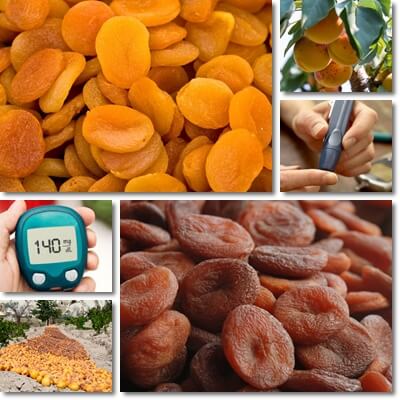Most diabetics can eat just about anything so long as intake is limited to amounts that won’t cause blood sugar to go up too much. This means they can eat chocolate, fresh fruits and even dried fruits, just in small amounts. Of course, some foods are better tolerated than others and less likely to produce side effects for the diabetic patient. This is also the case with dried apricots which, surprisingly, are good for diabetic nutrition in small amounts and not likely to produce sudden and significant rises in blood sugar.
The biggest benefit of dried apricots specifically for diabetes is the low glycemic index. The glycemic index (GI) measures how the carbohydrates in a food raise blood sugar levels. The lower the GI, the better the food for blood sugar control. Below 55 is a low GI. Between 55-69 is a moderate GI. Over 70 is a high GI. Studies put the glycemic index of unsweetened dried apricots at 30 or slightly above, but no more than 45. In any case, it is a low glycemic index and means that eating dried apricots in moderation does not raise blood sugar levels too much, compared to other dried fruits.

The minimal effects of dried apricots on blood sugar are the cumulative result of several factors:
1) A generous fiber content (4-7 g of fiber per 100 g of the dry fruit);
2) The gummy, chewy texture and overall structure of the dried fruit (which influence how fast a food is digested and the nutrients in it absorbed or to what extent);
3) Higher percentage of the simple sugar fructose (estimated at 50% of total sugar content) – research shows fructose has slightly less of an effect on blood sugar levels compared to glucose.
4) Presence on antioxidants, vitamins and other elements with beneficial effects on blood sugar metabolism, including minor hypoglycemic effects, and various other aspects of diabetic health, including weight, energy metabolism and cardiovascular health.
5) Lack of additional sweetening, since apricots are naturally good tasting.
6) Limited intake, determined according to the diabetic patient’s individual nutritional requirements based on age, current weight, level of physical activity and the restrictions of the metabolic condition.
But not all foods of the same kind are created equal and that’s a variable that weighs heavily when considering a food, any food for diabetes. Depending on the initial carbohydrate and sugar content of the fruit (some varieties are sweeter, some fruits at their ripest when dried so they pack slightly more sugar), size (which differs with variety), allowed moisture content (which may be as high as 25%) and choice of drying method, some fruits retain more moisture and are bigger, while others retain less moisture and shrink more. So you won’t be getting the exact same amount of carbs and sugar for the same amount of dry apricots from different sources.
Dried vs fresh apricots nutrition facts and observations
Typically, one dried fruit will get you the same amount of carbs as one fresh fruit. 100 g of raw apricots have about 11.12 g of carbohydrates while one fruit with an estimated weight of 35 g gets you 3.89 g of carbohydrates. But when you dry the fruit, you may be concentrating the carbohydrates 2 times, 3 times, 4 times or more (depending on how much moisture is removed). Which makes it possible for 100 g of unsweetened dried apricots to provide anywhere from 28 g of carbohydrates to 62 g of carbohydrates, depending on how much it’s dried and its initial physical and chemical properties.

And because most of the carbohydrates in dried apricots are actually sugars, know that sugar content in unsweetened dried apricots may vary from 23 g per 100 g of fruit to 53.4 g for the same amount if the fruit are ultra-dried (because you get more fruit with more concentrated nutritional elements). This is a really big difference which matters if you are diabetic and need to watch your intake.
Serving size for diabetes
Dry apricot serving size for diabetics is estimated at a maximum of 30 g, which would provide anywhere between 9 to 20 g of carbohydrates and 6 to 17 g of sugars (estimate). 30 g may include approximately 8-9 halves of unsweetened dried apricot halves. It’s always best to read the label and find out just how much carbs you get in a serving of the dried fruit because not all dried fruit are made the same or provide the exact the same nutrition.
Some diabetics may tolerate more than one serving a day while others may need to spread their one serving over the course of an entire day to reduce effects on blood sugar and be able to eat the dried fruit safely with their condition. If you have diabetes, it helps to have your dry fruit after a meal, not before. It’s better to enjoy a low carbohydrate, light protein meal if you’re planning on having dried fruit. Ideally, count your carbs to allow for such a desert and not exceed your recommended intake of carbohydrates per meal and per day. Exercising afterwards can contribute to a better glycemic response and better insulin sensitivity.
Important: Just because they have a low glycemic index and slight hypoglycemic effects, that doesn’t mean you can eat as much dried apricots as you want. Eating too much at once cancels out the low glycemic index and resulting benefits and, instead, makes blood sugar go up, hence the need to practice moderation. So if you have diabetes, remember that the dried fruit is only good for you in small amounts.
List of benefits
Other than the fact that they have a low glycemic index and minimal effects on blood sugar levels when consumed in moderation, dried apricots nutrition further favors aspects of diabetic health and good general health. Some of the best benefits include:
1) Good fiber content for weight management and better digestion.
2) Rich in pro-vitamin A antioxidants for better vision (diabetic retinopathy is a major concern).
3) Benefits for skin from vitamins A, E and B3.
4) Minor benefits for wound healing thanks to the immune system modulating effects of vitamin A.
5) Benefits for diabetes-associated hypertension from high amounts of potassium.
6) More vitality from good amounts of iron.
7) Hypoglycemic effects from polyphenolic elements, vitamins and other compounds, seen especially in type 2 diabetes.
Conclusion
Apricots appear to be a good choice of food for diabetics so long as they are consumed in limited amounts as part of an overall balanced and varied diet. The main reason they are good for diabetes is because they have a low glycemic index and do not raise blood sugar levels too much compared to other dried fruits. This effect is believed to be a result of their chewy texture and nutritional composition, but is highly dependent on intake. What this means is that the more dried apricots you eat at once, the higher the glycemic response; the smaller the intake, the more favorable the glycemic response. Because not all diabetics can eat dried apricots in the same amounts, it is important to remember to adapt your intake to your individual nutritional requirements (and keep it low).
